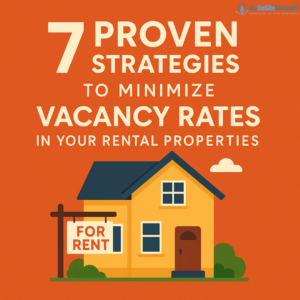 Vacant rental units don’t just collect dust—they drain your profits. For property owners and managers, high vacancy rates can be one of the biggest threats to consistent cash flow and long-term investment performance. That’s why minimizing vacancy should be a top priority.
Vacant rental units don’t just collect dust—they drain your profits. For property owners and managers, high vacancy rates can be one of the biggest threats to consistent cash flow and long-term investment performance. That’s why minimizing vacancy should be a top priority.
In this post, we break down seven practical and effective strategies to reduce vacancy time, based on insights from TrueNest Property Management.
1. Price Your Rental Competitively
Pricing is one of the first things prospective tenants notice—and it can make or break your ability to fill a vacancy quickly.
If your rent is set too high, even the best unit may sit idle. Too low, and you leave money on the table. Use comparable listings in your neighborhood to gauge market rates, factor in amenities and recent upgrades, and adjust your pricing seasonally to stay competitive.
Pro Tip: Monitor listings on Zillow, Apartments.com, and Facebook Marketplace weekly to stay updated on local trends.
2. Enhance Your Curb Appeal
First impressions matter. A property with clean landscaping, fresh paint, and a tidy entryway can set a welcoming tone before a tenant even steps inside.
Simple enhancements—like trimming bushes, power washing the exterior, or updating your signage—can significantly improve walk-by and drive-by appeal, attracting more qualified prospects.
Pro Tip: Include “before and after” photos in your online listings to showcase recent improvements.
3. Market Aggressively and Strategically
Your property could be perfect, but it won’t fill itself if no one knows it’s available. Successful leasing depends on visibility.
Create a compelling listing with high-quality photos, a clear and inviting headline, and a detailed, honest description. Promote it across multiple platforms, including MLS, Zillow, HotPads, Craigslist, Facebook, and your own website.
Pro Tip: Use video tours or 3D walkthroughs to stand out and give prospective tenants a virtual showing option.
4. Screen Tenants Thoroughly
One of the best ways to reduce future vacancies is to find long-term, responsible tenants from the start. A solid screening process can help you do just that.
Check credit scores, income-to-rent ratios, criminal backgrounds, rental histories, and references. Look for red flags like prior evictions or inconsistent income.
Pro Tip: Set clear, written criteria to keep the screening process consistent, compliant, and fair.
5. Build Strong Tenant Relationships
Tenants are more likely to renew their lease if they feel respected and taken care of. Communication, responsiveness, and fair treatment go a long way in fostering loyalty.
Respond to maintenance requests promptly, conduct inspections with proper notice, and keep your tone professional and friendly. Small gestures like welcome kits or seasonal maintenance reminders show tenants that you care.
Pro Tip: Use property management software to streamline communication and stay organized.
6. Offer Incentives for Lease Signing or Renewal
If your unit has been sitting too long or competition is steep, consider offering a strategic incentive.
Incentives like a discounted first month’s rent, a free parking spot, or an upgraded appliance package can help close the deal faster. For existing tenants, offer small renewal bonuses like carpet cleaning or a minor renovation.
Pro Tip: Always calculate the cost of an incentive against the cost of a prolonged vacancy—it’s often worth it.
7. Reinvest in Property Upgrades
Properties that feel modern and well-maintained don’t stay empty for long. Periodically reinvesting in key areas—like kitchens, bathrooms, or flooring—can boost both desirability and rental value.
Even small upgrades like new hardware, light fixtures, or paint can transform the look and feel of a space.
Pro Tip: Focus on upgrades with high ROI—energy-efficient appliances, fresh paint, and durable flooring are great places to start.
Why Reducing Vacancy Matters
Vacancy doesn’t just impact your monthly income—it affects your entire financial picture. Prolonged vacancies mean more turnover costs, missed revenue, and possibly even a hit to your property’s market value.
By being proactive and strategic, landlords can keep units occupied, tenants happy, and profits stable.
Final Thoughts
Minimizing vacancy rates isn’t about luck—it’s about smart, consistent action. With the right strategies in place—from pricing and curb appeal to screening and communication—you can dramatically reduce downtime between tenants and maximize your rental ROI.
Source: TrueNest Property Management – How to Minimize Vacancy Rates
